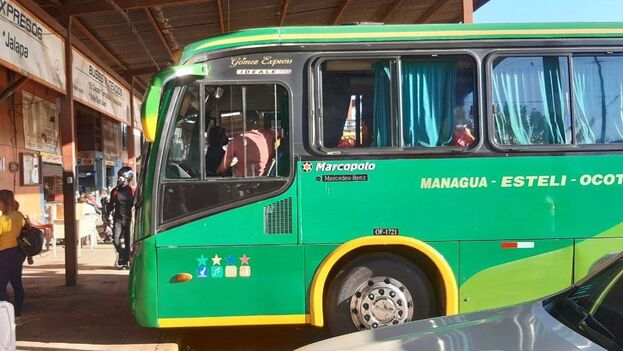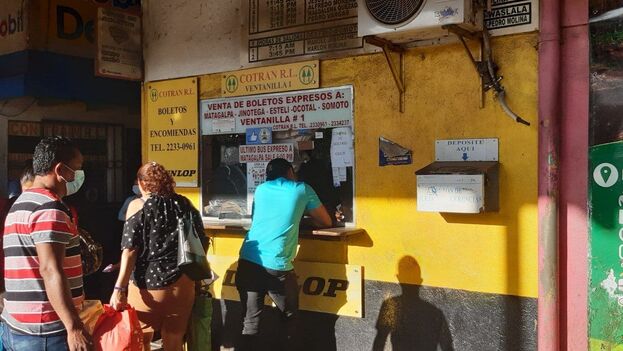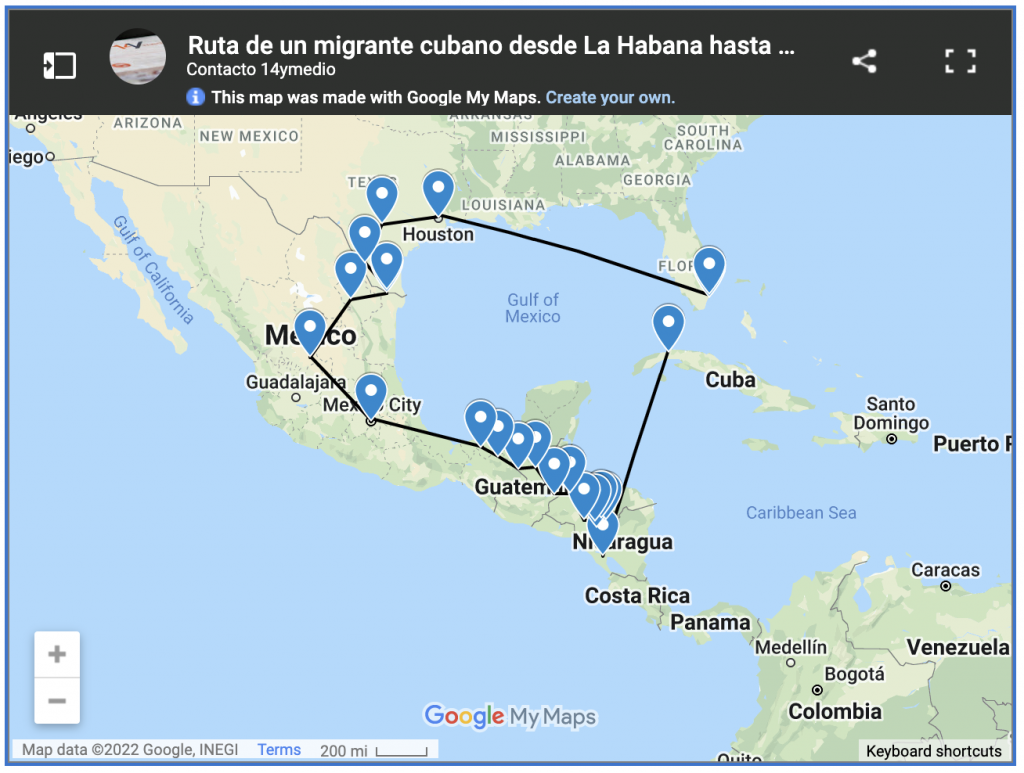
![]() 14ymedio, Alejandro Mena Ortiz, 23 April 2022 — I had never left Cuba in my life, so emigrating was the most difficult decision I have ever made. I had to painfully say goodbye to the people I love: my children, my grandmother, my mother, my father, my wife, my brothers. There is only one reason to have done it: despair.
14ymedio, Alejandro Mena Ortiz, 23 April 2022 — I had never left Cuba in my life, so emigrating was the most difficult decision I have ever made. I had to painfully say goodbye to the people I love: my children, my grandmother, my mother, my father, my wife, my brothers. There is only one reason to have done it: despair.
Thanks to a relative overseas, I managed to arrange a ticket to travel to Nicaragua. My plan was, like that of so many others, to later cross Honduras, Guatemala and Mexico until I reached the United States. Before leaving, many feelings collided within me. On the one hand, I felt very sad and disillusioned with my country, but at the same time, I was looking forward to finally having the opportunity to carve out a future for my children.
During the trip to the airport, I trembled with anguish: I felt that I was leaving everyone behind and that I had a very uncertain future ahead of me. At the José Martí Airport there was a line of 150 people. Even to escape from this country you have to wait in line.
The vast majority of passengers talked about the same thing: where they planned to leave from, how much their ‘coyotes’ charged them, who they would travel with…
I had a very stressful time at Immigration, when, as they checked my details and my passport, they asked me to wait. After a few minutes that seemed like forever, an official looked at me and said contemptuously: “Oh, he’s from Archipíelago [platform].”
I had given my name at the beginning, when Yunior García Aguilera formed the group, but I didn’t think that it would leave a mark on me. The officers told me to relax, but the passengers on my flight were already in the waiting room and I was still there. Finally, they let me go: “Have a good trip,” the official told me with indifference. Later, I heard more similar testimonies: they maintain uncertainty until the end. Until the plane took off, it was not clear to me that they would not make me disembark.
The vast majority of passengers talked about the same things: where they planned to leave, how much their coyotes charged them, who they would travel with… Nobody around me was going to Nicaragua as their final destination. It was a mass exodus before my eyes.
The treatment was not very good upon arrival in Nicaragua. As soon as I arrived, I was scammed into buying a Claro phone card for $20 that was supposed to have 13 GB of data and unlimited social networks, among other benefits. The next day, I had to recharge it for 100 córdobas, about three dollars.
Observing Managua from the plane, all lit up, shocked me. At the airport and on the way to the hotel, many advertisements, cafes, restaurants. The hotel was nothing to write home about, but it was cozy and had a pool. However, no one was swimming. It is hot in Managua and no Cuban goes swimming, because everyone knows what they are there for.
The first day I went out with a guy I had met and we passed by a gas station. My impression was great when we entered that tiny gas station and saw the immense variety of products they sold: all kinds of gum, chocolates, soft drinks, hotdogs… And that still hadn’t reached Walmart. I can’t even describe here what I felt when I saw all that abundance, all that immense space, with so much and so much merchandise, so varied. I didn’t even know in what direction to walk.
Then I felt very sad. I didn’t understand why we didn’t have these things in my country, why we have to go through so much trouble to buy a piece of frozen chicken or some hamburger meat or some eggs to be able to eat. When I got back to the hotel I talked to my family on WhatsApp and I got a lump in my throat, I felt very powerless to be able to have all that here and that they didn’t have it there.
The coyotes came to pick up many Cubans here during the first day and a half that I was there. I met two of them. One was a medical student in Cienfuegos and he told me that he had to take advantage of the opportunity, because in the third year they are regulated and they cannot leave Cuba. The boy has family abroad and he paid $6,000 to be dropped off at the border. He was nervous and I tried to calm him down by encouraging him.
One was a medical student in Cienfuegos and he told me that he had to take advantage of the opportunity, because in the third year they are regulated and they cannot leave Cuba
The other was named Lazarito, a slightly confused boy, from Havana. His father is in the US and paid for his ticket, in addition to the $7,000 for the coyote. He was even more nervous, because the coyotes had to come pick him up at 6:00 in the morning. They arrived at 8:00 and he finally left with them.
My trip began one day at 6:30 in the morning, when a taxi picked me up and left me at the Managua bus station. There, I boarded a bus to Ocotal, in the north of the country.
It was a very calm trip, very beautiful, the landscapes caught my attention, the fields of Nicaragua are planted, not like those of Cuba. On the way, I talked with Brenda, a 38-year-old Nicaraguan who lives in Ocotal but works in Managua, and she told me that she has three children. She works in the house of a rich man, she told me, taking care of the children, and she only gets four days off a month. During those four days, she takes a bus, takes care of her family and returns, and spends one more month locked in that house. She has been doing it for 5 years, she says, to ensure a future for her children.

I got off at Ocotal, which despite being a small town has many things, something that continues to impress me wherever I go. There, something caught my attention that I did not see in Managua: a lot of Sandinista propaganda. I arrived at my guide’s house, where I rested and was able to taste Nicaraguan beer, La Toña, very tasty, very similar to the Cuban Cristal, which brought back many memories. In the afternoon, we left for the border, a fairly long journey but in a very comfortable van.
It was night when we arrived at the border crossing, which connects the municipality of Jalapa, in Nicaragua, with a very small town called Trojes, in southern Honduras.
There, we got out of the car in the middle of a field and had to cross an area of crops that measured about 400 meters, in total darkness. There was practically nothing to be seen and we had to walk fast so that the police would not catch us. On the other side, there was a barbed wire fence, and a man with a motorcycle was waiting for me. The guy revved it up to about a million mph, and it was cold. My forehead froze, but in just three minutes, I was already in Trojes.
Translated by Norma Whiting

Tomorrow: Caravan through Honduras — there were 30 Cubans traveling on motorcycles.
____________
COLLABORATE WITH OUR WORK: The 14ymedio team is committed to practicing serious journalism that reflects Cuba’s reality in all its depth. Thank you for joining us on this long journey. We invite you to continue supporting us by becoming a member of 14ymedio now. Together we can continue transforming journalism in Cuba.
